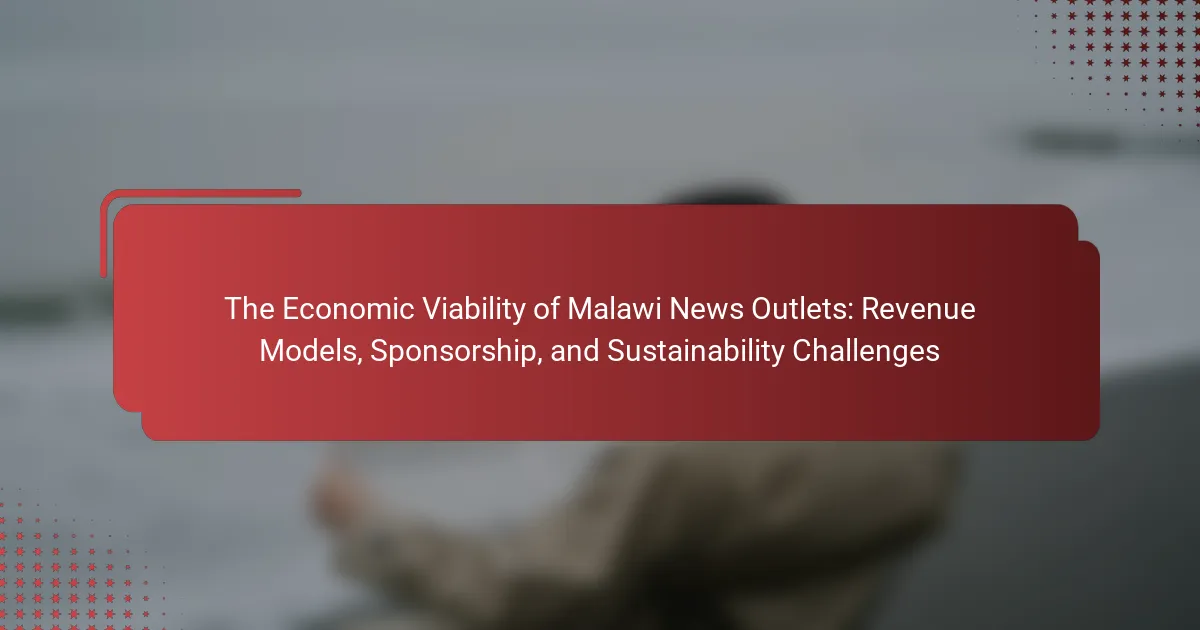The article examines the economic viability of news outlets in Malawi, focusing on their revenue models, sponsorship opportunities, and sustainability challenges. It highlights the reliance on advertising, which is hampered by a small market size and inconsistent sponsorship from local businesses. The discussion includes the impact of external factors such as political stability, economic conditions, and technological advancements on advertising budgets and consumer spending. Additionally, strategies for diversifying revenue streams, including subscription models and digital engagement, are explored as potential solutions for enhancing financial sustainability in the Malawian media landscape.

What is the Economic Viability of Malawi News Outlets?
The economic viability of Malawi news outlets is challenged by limited revenue streams and high operational costs. Many outlets rely on advertising, which is often insufficient due to a small market size. Subscription models are not widely adopted, limiting financial sustainability. Sponsorship from local businesses is common but inconsistent. Furthermore, the economic environment in Malawi affects advertising budgets. According to a 2021 report by the Media Institute of Southern Africa, many outlets struggle to maintain profitability. The lack of diversified income sources exacerbates these challenges. Overall, the economic landscape poses significant hurdles for the sustainability of news outlets in Malawi.
How do revenue models impact the sustainability of news outlets in Malawi?
Revenue models significantly impact the sustainability of news outlets in Malawi. Diverse revenue streams enhance financial stability for these outlets. Advertising, subscriptions, and sponsorships are common models used. In Malawi, many news outlets struggle with low advertising revenue. This is due to a limited local market and economic challenges. Subscription models are less prevalent, as many citizens cannot afford them. Consequently, reliance on a single revenue model can jeopardize operations. Studies indicate that outlets with multiple revenue sources are more resilient. For example, a report by the Media Institute of Southern Africa highlights that diversification improves sustainability. Overall, effective revenue models are crucial for the longevity of news outlets in Malawi.
What are the primary revenue models used by Malawi news outlets?
Malawi news outlets primarily use advertising, subscriptions, and sponsorship as their revenue models. Advertising remains the most significant source of income for many outlets. This includes both print and digital advertisements. Subscriptions provide a steady income stream, especially for online platforms. Sponsorship deals with various organizations also contribute to their financial sustainability. Additionally, some outlets may receive funding from international donors or NGOs. These revenue models are crucial for the operational viability of news organizations in Malawi.
How effective are these revenue models in generating income?
Revenue models in Malawi news outlets are moderately effective in generating income. These models include advertising, subscriptions, and sponsorships. Advertising remains a primary source of revenue, contributing significantly to financial stability. However, the overall market for advertising is limited in Malawi. Subscription models provide a steady income stream but face challenges with low [censured] rates. Sponsorships can enhance revenue but often depend on external funding and partnerships. Research indicates that diversification of revenue streams is crucial for sustainability. A study by the International Journal of Media Management found that outlets with multiple revenue sources tend to perform better financially.
What role does sponsorship play in supporting Malawi news outlets?
Sponsorship plays a crucial role in supporting Malawi news outlets by providing essential funding for operations. Many news organizations in Malawi face financial challenges due to limited advertising revenue. Sponsorship offers a reliable source of income that can be allocated to news production and staff salaries. Additionally, sponsorship can enhance the credibility of news outlets by associating them with reputable brands. This relationship can lead to increased audience trust and engagement. For instance, sponsorship deals often include promotional support that helps news outlets reach wider audiences. Furthermore, sponsors may be interested in specific content that aligns with their brand values, which can influence editorial decisions. Overall, sponsorship is vital for the sustainability of Malawi news outlets in a challenging economic landscape.
How do sponsorship agreements affect the editorial independence of news outlets?
Sponsorship agreements can compromise the editorial independence of news outlets. These agreements may lead to biased reporting, as financial sponsors may exert influence over content. News outlets might prioritize the interests of sponsors over journalistic integrity. Studies indicate that sponsored content can blur the lines between advertising and journalism. This can result in a loss of trust among audiences. For example, a 2020 report by the Pew Research Center found that 63% of Americans believe that sponsorship can distort news coverage. Therefore, while sponsorship provides financial support, it poses risks to the independence and credibility of news organizations.
What types of sponsors are most common for Malawi news outlets?
Common sponsors for Malawi news outlets include government entities, NGOs, and private businesses. Government entities often provide funding to promote transparency and public information. NGOs sponsor news outlets to raise awareness about social issues and community development. Private businesses seek advertising opportunities to enhance brand visibility. This sponsorship model is crucial for the financial sustainability of news outlets in Malawi. Research indicates that these diverse sponsorship types help maintain journalistic independence while ensuring operational viability.
What are the major sustainability challenges faced by Malawi news outlets?
Malawi news outlets face significant sustainability challenges. Limited advertising revenue impacts their financial stability. High operational costs further strain their budgets. Additionally, the dominance of social media reduces traditional news consumption. Low internet [censured] in rural areas limits audience reach. Dependence on donor funding creates uncertainty and affects independence. Lastly, regulatory pressures can hinder operational flexibility.
How do economic conditions in Malawi influence news outlet operations?
Economic conditions in Malawi significantly influence news outlet operations. Limited advertising revenue affects financial stability. High levels of poverty restrict consumer spending on subscriptions. Economic instability leads to fluctuating operational costs for news outlets. Additionally, inflation impacts the cost of newsprint and digital infrastructure. Poor economic conditions can reduce government advertising budgets, further straining resources. The need for diverse revenue models becomes critical in challenging economic climates. News outlets may rely more on sponsorships or donor funding to survive. These factors collectively shape the operational strategies of news outlets in Malawi.
What strategies can news outlets employ to overcome these sustainability challenges?
News outlets can employ diverse strategies to overcome sustainability challenges. They can diversify revenue streams by incorporating digital subscriptions, advertising, and sponsored content. Implementing paywalls for premium content can generate consistent income. Partnerships with local businesses can enhance community engagement and sponsorship opportunities. Investing in audience analytics can help tailor content to meet reader preferences, increasing loyalty and ad revenue. Training staff in multimedia skills can improve content quality and reach across platforms. Exploring grants and funding from NGOs can provide additional financial support. Collaborating with other media organizations can reduce costs and expand audience reach. These strategies align with trends in the media industry, where adaptability is crucial for long-term sustainability.

How do external factors influence the economic viability of Malawi news outlets?
External factors significantly influence the economic viability of Malawi news outlets. Political stability affects advertising revenue and audience trust. Economic conditions impact consumer spending on media subscriptions and advertising. Technological advancements shape distribution channels and content accessibility. Regulatory frameworks dictate operational costs and compliance requirements. Social media competition can reduce traditional news outlet readership. Global economic trends influence foreign investment in local media. These factors collectively determine the financial sustainability of news outlets in Malawi.
What impact does the digital landscape have on revenue generation?
The digital landscape significantly enhances revenue generation for businesses. It provides access to a global audience, increasing potential customer bases. Online platforms enable targeted advertising, which improves marketing efficiency. E-commerce capabilities allow direct sales to consumers, bypassing traditional retail costs. Data analytics tools help businesses understand consumer behavior and preferences. According to a report by Statista, global e-commerce sales reached approximately $4.28 trillion in 2020. This growth illustrates the financial benefits of digital engagement. Additionally, social media channels facilitate brand awareness and customer interaction, driving sales. Overall, the digital landscape transforms revenue opportunities for various sectors.
How are traditional news outlets adapting to digital platforms?
Traditional news outlets are adapting to digital platforms by enhancing their online presence. They are investing in websites and mobile applications to reach broader audiences. Many are utilizing social media for real-time news dissemination. This approach helps engage younger demographics who prefer digital content. Additionally, news organizations are implementing paywalls and subscription models to generate revenue. According to a report by the Pew Research Center, 70% of U.S. news organizations have adopted a digital-first strategy. Traditional outlets are also offering multimedia content, such as videos and podcasts, to attract diverse audiences. This shift reflects the need for sustainability in the evolving media landscape.
What new revenue opportunities arise from digital engagement?
Digital engagement creates new revenue opportunities for Malawi news outlets. These opportunities include subscription models, which allow users to pay for premium content. Advertisements on digital platforms can reach targeted audiences, increasing revenue potential. Sponsored content provides a way to collaborate with brands for mutual benefits. Crowdfunding campaigns can generate funds directly from the audience. Affiliate marketing offers commissions for promoting products or services. Data analytics can help outlets tailor content to audience preferences, enhancing engagement and monetization. These strategies have been successfully implemented by various global news outlets, demonstrating their effectiveness.
How does audience engagement affect the financial health of news outlets?
Audience engagement directly impacts the financial health of news outlets by driving revenue through subscriptions and advertising. Higher engagement levels lead to increased reader loyalty. Loyal readers are more likely to subscribe to paid content. Additionally, engaged audiences attract advertisers seeking targeted reach. According to a 2021 Pew Research Center study, news outlets with higher audience interaction reported a 20% increase in ad revenue. This correlation highlights the importance of engagement strategies for financial sustainability. Engaging content fosters a community, encouraging more frequent visits and interactions. More interactions result in better analytics, allowing outlets to optimize their offerings and attract more advertisers.
What strategies can be employed to increase audience loyalty?
To increase audience loyalty, news outlets should focus on delivering consistent, high-quality content. Engaging storytelling and accurate reporting build trust with the audience. Personalization through tailored content enhances user experience. Implementing feedback mechanisms allows audiences to voice their preferences. Regular interaction via social media strengthens community ties. Offering exclusive content or rewards encourages audience retention. Research shows that 70% of consumers are more likely to stay loyal to brands that engage with them. Building a strong brand identity fosters emotional connections, increasing loyalty.
How does audience feedback shape content and revenue strategies?
Audience feedback directly influences content and revenue strategies in news outlets. It allows organizations to understand audience preferences and interests. By analyzing feedback, outlets can tailor content to meet these demands. This alignment often leads to increased engagement and loyalty among readers. Higher engagement can translate into more advertising revenue. For instance, outlets that prioritize feedback may see a 30% increase in reader retention. Additionally, audience insights can guide sponsorship opportunities, ensuring relevance and effectiveness. Overall, audience feedback is a critical component for optimizing both content and revenue strategies in news media.

What best practices can enhance the economic viability of Malawi news outlets?
Diversifying revenue streams enhances the economic viability of Malawi news outlets. This includes incorporating subscription models alongside traditional advertising. Offering premium content can attract paying subscribers. Collaborating with local businesses for sponsorships can provide additional funding. Investing in digital platforms increases audience reach and engagement. Training staff in digital journalism improves content quality and relevance. Utilizing social media effectively can drive traffic and ad revenue. Engaging with the community fosters loyalty and encourages local support. These practices are supported by examples of successful media outlets in similar markets.
What innovative revenue strategies are being explored by news outlets?
News outlets are exploring subscription models, branded content, and digital advertising as innovative revenue strategies. Subscription models provide a steady income stream by charging readers for access to premium content. Branded content allows news outlets to collaborate with businesses for sponsored articles that align with their audience. Digital advertising has evolved with targeted ads that leverage user data for better engagement. Additionally, crowdfunding initiatives are gaining traction, enabling audiences to support journalism directly. These strategies reflect a shift towards diversifying revenue sources in response to declining traditional advertising revenues.
How can collaboration with local businesses bolster financial support?
Collaboration with local businesses can bolster financial support for Malawi news outlets through mutual promotion and resource sharing. Local businesses can provide advertising revenue in exchange for visibility in news content. This creates a symbiotic relationship where both parties benefit financially. Additionally, joint events can be organized, generating income while enhancing community engagement. Research indicates that local partnerships can increase audience reach, leading to higher subscription rates. A study by the Media Institute of Southern Africa found that local collaborations improved financial stability for media outlets by 30%.
What role does community involvement play in sustaining news outlets?
Community involvement is crucial for sustaining news outlets. It fosters local engagement and builds trust between the outlet and its audience. When communities actively participate, they provide valuable feedback and content ideas. This engagement can lead to increased readership and loyalty. According to a study by the Knight Foundation, community-supported journalism models have seen higher success rates in local news. Financial contributions from the community, such as subscriptions and donations, directly support operational costs. Additionally, community involvement can enhance the relevance of news coverage, making it more aligned with local interests. Ultimately, strong community ties can lead to a more resilient news outlet.
What lessons can be learned from successful news outlets in similar contexts?
Successful news outlets demonstrate the importance of diversifying revenue streams. They often combine advertising, subscriptions, and sponsorship to ensure financial stability. For instance, The Guardian relies on reader contributions alongside traditional advertising. This model allows for greater independence and sustainability.
Additionally, successful outlets engage deeply with their communities. They tailor content to local interests, fostering loyalty and increasing readership. NPR exemplifies this by focusing on local stories that resonate with its audience.
Moreover, embracing digital transformation is crucial. Many successful outlets invest in online platforms and social media to reach broader audiences. The New York Times has effectively used digital subscriptions to boost revenue.
Lastly, transparency and trust are vital. Outlets that prioritize fact-checking and ethical journalism build credibility. A 2021 Pew Research study found that trust in news is linked to perceived accuracy and transparency. These lessons indicate that adaptability, community engagement, digital innovation, and trust are key to the viability of news outlets in similar contexts.
How do these successful outlets navigate sponsorship and revenue challenges?
Successful outlets navigate sponsorship and revenue challenges through diversified funding strategies. They often combine advertising, subscription models, and grants to create a stable income stream. For instance, some outlets engage in partnerships with local businesses for sponsorship deals. These partnerships can provide financial support while enhancing community engagement. Additionally, successful outlets leverage digital platforms to expand their reach and attract online advertisers. They also create unique content that appeals to niche audiences, increasing their value to sponsors. According to the Media Institute of Southern Africa, outlets that adapt to changing media consumption habits are more likely to secure sustainable revenue.
What practical steps can struggling outlets take to improve their viability?
Struggling outlets can improve their viability by diversifying revenue streams. This includes exploring subscription models, which have seen success in various media markets. Offering premium content can incentivize readers to pay for quality journalism. Additionally, outlets should seek local sponsorships and partnerships with businesses to create mutually beneficial relationships. Implementing targeted advertising strategies can also enhance revenue. Engaging with the community through events or workshops can increase visibility and foster loyalty. Utilizing digital platforms effectively can expand reach and attract a broader audience. Investing in training for staff can improve content quality and operational efficiency. These steps are supported by trends showing that diversified revenue models contribute to media sustainability.
The main entity of this article is the economic viability of Malawi news outlets. The article examines the challenges these outlets face, including limited revenue streams from advertising, subscriptions, and sponsorships, which hinder their financial sustainability. It highlights the impact of economic conditions and external factors on news outlet operations, as well as the importance of diversified revenue models. Additionally, the article explores the role of sponsorship in supporting news organizations while addressing concerns regarding editorial independence. Strategies for overcoming sustainability challenges and lessons from successful news outlets in similar contexts are also discussed.




